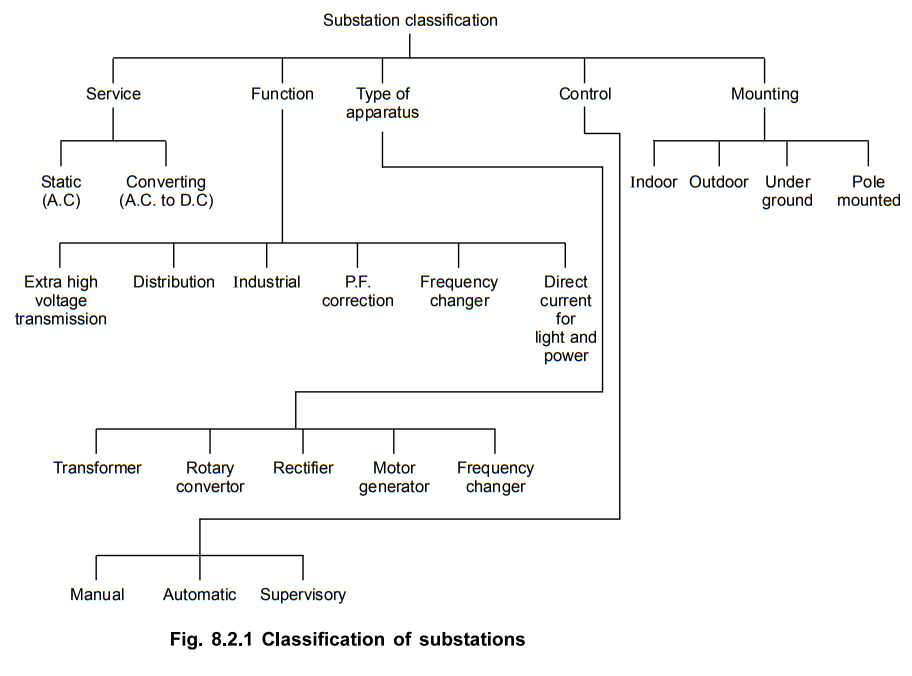Transmission and Distribution: Unit V: (b) Substations and Grounding
Classification of Substations
Substations and Grounding
Questions : 1. Explain in brief about the classification of substation. 2. Explain different types of substations.
Classification of
Substations
AU: May-12 There are several ways of
classification of substations which are as shown in the Fig. 8.2.1.

Most of the types of substations as
shown are self explanatory.
The static substations are stations from
where power is transmitted to various load centres. They are either step up or
primary substations or secondary substations which fed power directly to load
and remaining power is transmitted. The converting substations change a.c.
power to d.c. power with suitable equipments for giving supply to traction,
welding or electroplating.
The extra high voltage transmission
substations come under the category of transformer substations which change
voltage levels. They receive power at some voltage and delivery of power is
made at some other voltage. Transformer is their main component. High voltage
substations operate with voltage level between 11 kV and 66 kV. Extra high
voltage substations operate in the voltage range of upto 400 kV. The voltage
ranges above 400 kV are handled by ultra high voltage substations.
The distribution substations convert
voltage levels to low value for the use of electrical power to consumers. The
distribution is carried by 3 phase, 4 wire system with line to line voltage of
400 volts and line to phase voltage of 230 volts. The grid substations are
those from where bulk power is transmitted from one point to other in the grid.
Any disturbance in these substations may cause failure to the grid.
The industrial substations supply power
to the individual industrial consumers who need bulk power.
For improving the power factor of the
system, power factor correcting substations are installed. As the transmission line
is loaded, voltage decreases while it increases when load on the line is
lowered. Thus due to inductance and capacitance of line, large variations in
voltage and power factor occur. Thus at the receiving ends, synchronous
condensers or other power factor improving devices are installed.
The substations which change the supply
frequency is known as frequency changeover substation. In industrial
applications frequency other than supply frequency is required which can be
obtained from these substations.
According to constructional features,
the substations are divided as indoor, outdoor, pole mounted or underground.
In indoor substation, the equipments of
substation such as circuit breakers, switching fuses, instruments etc are
installed indoor for having better economy. The voltage handled by these
substations is upto 11 kV.
These substations consist of series of
open and enclosed chambers or compartments. The main equipment of given
installation is arranged in these compartments. These are further subdivided as
substations of integrally built type where apparatus is installed on site. The
cell structures are constructed of concrete. Substations of composite built
type contains assemblies which are prefabricated but installed on site. The
compartments of such substation take form of metal cabinets. The unit type
factory fabricated substations are built in workshop or factory and transported
to the site. Only incoming and outgoing power circuits are to be made. Fully
enclosed metal clad cabinets are used.
For voltages beyond 66 kV, outdoor
substations are used as the clearances required between conductors and space
required for other apparatus is so large that indoor installation proves to be
uneconomical. It is further divided into pole mounted or foundation mounted
substations.
The pole mounted substation is meant for
distribution. It is the cheapest form of substation as no building work is
involved. These substations are erected for mounting distribution transformers
upto 250 kVA capacity. All the equipments are outdoor type and are mounted on
H-type pole or 4 pole structure.
The incoming line (normally 11 kV) is
supplied to the transformer through gang isolator and fuses. The mechanically
operated triple pole switch is used for switching on or off of H.T. (High
Tension) line. The lightning arrestors are installed to protect the substation
against lightning strokes. The oil circuit breaker automatically isolates the
transformer in case of fault. This substation is erected in thickly populated
location. The maintenance cost of these substations is low.
The foundation mounted substations are
built entirely in open and in such substations all the equipments are assembled
into one unit usually enclosed by a fence for safety reasons. Substations for
primary and secondary transmission and for secondary distribution (Above 250
kVA) are foundation mounted outdoor type. As the equipments required are heavy,
the site selected for these substations must have good access for
transportation.
Underground substations are installed
where there is shortage of land or land price is very high. The design of these
substations requires critical considerations. Its size should be as minimum as
possible with reasonable access to personnel and equipments. It should have
provision for emergency lighting, good ventilation, indication of excessive
rise in temperature to disconnect H.T. supply and protection against fire.
In addition to above types there are
special types of substations which are as mentioned below :
1) Mining substations -
These are underground and are required for very special purposes.
2) Mobile substations -
This is also a special purpose substation required mainly for temporary
requirements such as for construction purposes.
3) Cinematograph substations -
It is used to meet specific requirements.
Review Questions
1. Explain in brief about the classification of substation.
2. Explain different types of substations.
Transmission and Distribution: Unit V: (b) Substations and Grounding : Tag: : Substations and Grounding - Classification of Substations
Related Topics
Related Subjects
Transmission and Distribution
EE3401 TD 4th Semester EEE Dept | 2021 Regulation | 4th Semester EEE Dept 2021 Regulation
